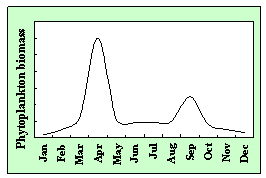|
|
 |
|
|
|
 |
| |
|
|
 |
The Oceans
Basics |
Seasonal cycle of phytoplankton growth
There is a well defined seasonal pattern of phytoplankton growth in the temperate and polar oceans. It is controlled by physical, biological and chemical processes.
|
 |
 |
|
1. Seasonal cycle of phytoplankton in Nothern Hemisphere temperate oceans. Highest phytoplankton growth is seen in the spring when there is plenty of light and nutrients. A secondary peak in phytoplankton biomass occurs in the autumn. These large growths of phytoplankton are known as blooms. Author: Lucinda Spokes.
|
|
|
|
|
 |
|
The density of seawater is controlled by its temperature and how salty it is. As the temperature of water increases due to heating from the sun, the water molecules become more energetic, there is more space between them and the density decreases. As temperature lowers, the water molecules have less energy, don't move around as much and are closer together. This allows more hydrogen bonding to occur and the density increases.
The salinity of water is a measure of how many salts are dissolved in it. The most common salt by far in seawater is sodium chloride (common table salt) but there are also lots of other chemicals dissolved in seawater which have some effect on the salinity of the water. Evaporation of water from the ocean increases its density. Inputs of rain and river water decreases the density of the water. The result of changes in temperature and salinity around the globe leads to an ocean which has a layered structure made up of water bodies of different densities. Less dense waters float on top of more dense waters.
As we are interested in processes which control the growth of phytoplankton, we will concentrate on how changes in heating affect the vertical structure of the first few hundred meters of the ocean.
|
 |
 |
|
2. Black circles represent nutrients, green circles are phytoplankton.
|
|
 |
Spring
In the spring, the sun heats the surface waters of the ocean making them less dense. This warm water effectively floats on top of the colder, more dense, waters below and there is almost no mixing between them. This means that the growing phytoplankton are kept in the surface waters. Here they have plenty of light and nutrients which were mixed up from the deep waters during winter. These conditions are excellent for phytoplankton growth. Rapid increases in phytoplankton numbers are seen and this is called the spring bloom.
|
 |
 |
|
3. phytoplankton growth in summer
|
|
 |
Summmer
As the phytoplankton grow, they use up the nutrients in the surface waters. Since there is little mixing with the waters below, the phytoplankton stop growing when all the available nutrients have been used up. Remineralisation of nutrients in the surface waters and inputs of nutrients from the atmosphere do allow some phytoplankton growth but the summer isn't a very biologically active time in temperate latitudes compared to the spring.
|
 |
 |
|
4. small phytoplankton bloom in autumn
|
|
 |
Autumn
Less heating from the sun as the day length becomes shorter means that the surface waters cool down and their density increases. Because there is a smaller density difference between the surface waters and the waters below, a little mixing between them occurs. This allows some nutrient rich waters to mix into the surface and, as there is still enough light for photosynthesis, a small phytoplankton bloom sometimes occurs.
|
 |
 |
|
5. How seasonal heating changes the structure and functioning of the first few hundred meters of the ocean. Author: Lucinda Spokes, based on work by Stephanie Henson.
|
|
 |
Winter
In the winter, even less heating from the sun means that the surface waters cool further, increasing their density. This allows the surface waters to mix with the waters below. This mixing brings deep water nutrients back to the surface. Although there are plenty of nutrients, there isn't enough light for phytoplankton to photosynthesise effectively so not much grows.
|
|
In the tropics this seasonal cycle isn't as pronounced as the strength of the sun doesn't vary much through out the year and phytoplankton can grow all the time.
About this page:
author: Dr. Lucinda Spokes - Environmental Sciences, University of East Anglia, Norwich - U.K.
scientific reviewers: Prof. Tim Jickells - Environmental Sciences, University of East Anglia, Norwich - U.K. and Dr. Keith Weston - Environmental Sciences, University of East Anglia, Norwich - U.K.
educational reviewers: Francis Mudge - School of Education and Professional Development, University of East Anglia, Norwich - U.K. and Trevor Leggett - Chemistry Teacher, Norwich - U.K.
last updated: 2003-10-16
|
|
 |
|







